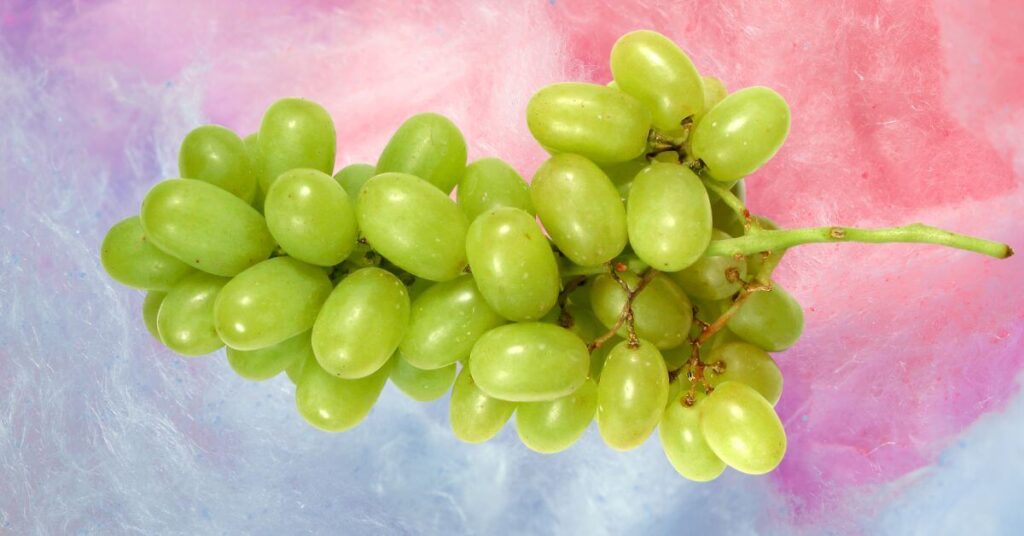
If you’ve ever wondered how are cotton candy grapes made, you’re in for a treat. These unique grapes taste like real cotton candy. Let’s delve into the fascinating history behind these unique grapes and how they are made.
The Creation of Cotton Candy Grapes
Cotton candy grapes were developed by plant breeders in California using traditional cross-breeding techniques without genetic engineering or artificial flavors. The International Fruit Genetics (IFG) created this grape by hybridizing a seedless Concord grape with a seeded Vitis labrusca species. This is how the cotton candy grape came to be.
Hybridization Process Involving Pollen from Two Different Grape Varieties
To create the perfect blend of flavor, IFG chose pollen from two different grape varieties to pollinate their plants. The process involves taking pollen from one variety and applying it to the flowers of another variety. This allows them to combine their traits naturally through fertilization. This centuries-old practice of combining traits from two distinct varieties has been used to cultivate plants with the desired attributes, such as flavor, hue, shape, and immunity to illnesses.
Selection of 10,000 Plants for Taste-Testing
In order to find the best-tasting hybrid among thousands of potential candidates, Cain’s team had an arduous task ahead: they needed to taste-test over 10,000 plants. Each year during harvest season on the West Coast, where these green grapes are grown, they would sample each plant’s fruit individually before narrowing down their selection based on flavor profile similarities between real cotton candy and table grapes naturally occurring within those samples.
Growing Techniques for Cotton Candy Grapes
Currently available only through one supplier due to its specific harvest time requirements and limited production scale, they retail at approximately $6 per pound but remain popular despite their premium price tag.
Cultivating Seedless Grapes in Test Tubes
One of the unique aspects of growing cotton candy grapes is that they start their life inside a lab. The process begins with the hybridization of two different grape species, which involves combining pollen from both varieties to create a new seedling. Once the seedlings have been grown and selected for their desirable traits (such as taste), they are transferred into test tubes containing nutrient-rich agar gel to continue developing.
Controlled Outdoor Growth Conditions
Once cotton candy grapes have matured enough within their test tubes, they are carefully transplanted outdoors under highly controlled conditions. This ensures optimal growth while minimizing potential risks associated with traditional outdoor farming methods:
- Irrigation systems: To maintain proper hydration levels for healthy vine development, precise irrigation systems deliver water directly to each plant’s root system rather than relying on rainfall alone.
- Temperature control: Grape vines are sensitive to temperature fluctuations, so growers must carefully monitor and adjust the climate within their vineyards to ensure optimal growth conditions.
- Pest management: Pesticide use is kept to a minimum by employing natural pest deterrents, such as introducing beneficial insects that prey on common grape pests like aphids or mites.
Growing cotton candy grapes requires specialized techniques and careful attention from start to finish. The result is a unique and delicious fruit that has captured the hearts of food lovers around the world.
Other Candy-Flavored Grape Varieties
Besides cotton candy grapes, there are several other candy-flavored grapes, and some examples include:
- Flavor Pops: A series of table grapes that taste like popular candies.
- Moon Drops: Uniquely shaped black grapes with a sweet flavor profile similar to licorice.
- Gum Drop Grapes: A variety that is known for its juicy texture and gumdrop flavor.
- Sweet Sapphire Grapes: A dark purple grape with a rich, sweet taste.
FAQs
How are cotton candy grapes made?
Cotton candy grapes are created through a natural hybridization process involving the cross-pollination of two different grape varieties. This is done by carefully selecting and breeding plants with desirable traits, such as sweetness and seedlessness, over several generations until the desired flavor profile is achieved.
Are cotton candy grapes healthy?
Yes, they are indeed healthy as they contain essential nutrients like vitamins C & K, potassium, antioxidants, and fiber found in regular grapes but are slightly higher in sugar.
Are cotton candy grapes good for weight loss?
Cotton candy grapes are a natural fruit that is not only delicious but can also be beneficial for your weight loss journey. They can help curb your cravings for unhealthy sweets, as they have a taste remarkably similar to that of cotton candy. They are also packed with nutrients, including antioxidants and vitamins, that contribute to a well-balanced meal plan.
Keep in mind that moderation is key, even with healthier options like cotton candy grapes. Consume them as part of a balanced diet, and remember that no single food can guarantee weight loss. Pair these grapes with wholesome meals and regular exercise to achieve the best results on your weight loss journey.
Are cotton candy grapes seedless?
Cotton candy grapes are not a natural variety of grapes. They were created through a process called genetic modification. This means that scientists used technology to alter the grape’s DNA to create a new variety with a unique flavor.
One of the benefits of genetic modification is that it allows scientists to create seedless grapes. This is because they can remove the genes responsible for producing seeds. As a result, cotton candy grapes are seedless.


